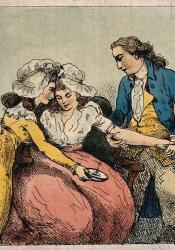Bloodletting
Bloodletting, the withdrawal of blood from patients to prevent or cure illnesses, first began over three thousand years ago in Egypt, but became very popular in Europe during the eighteenth and nineteenth century. Blood was drained by the use of phlebotomy, cutting open a vein with some sort of tool, or with leeches and was done so to treat fevers, hypertension, pulmonary inflammation and edema. Depending on the disease or illness, bloodletting would be conducted in different areas of the body, but it was traditionally performed at the elbows and knees. Most of the time, blood would be drained until the patient reached syncope, a state of unconsciousness caused by a lack of blood flow to the brain (fainting). A loss of a large amount of blood can severely lower a person's heart rate and leave them in a calm, tranced state, as seen in The Tenant of Wildfell Hall with Arthur Huntingdon. Arthur treated Helen with the utmost disrespect while she tended to his every need, often very agitated and aggressive towards her. After being bled, Mr. Huntingdon became tranquil and accepting of Helen's services. He was the most pleasant when he was subdued by bloodletting. The popularity of bloodletting began to diminish after 1834, when Pierre Charles Alexandre Louise, referred to by many as "the father of modern epidemiology," presented evidence that bloodletting was ineffective in treating pneumonia. During the 1840s and 1850s, studies conducted by Louis Pasteur and Robert Koch destroyed the credibility of bloodletting in treating inflammation. Despite the notion that it may be ineffective and more dangerous than helpful, bloodletting continues to be used in alternative medicine today.
Work Cited
Bell, Timothy M. "A Brief History of Bloodletting." 2016. PDF File.
Brontë, Anne. "The Tenant of Wildfell Hall." COVE Studio, https://studio.covecollective.org/anthologies/frankenstein-or-the-modern-prometheus/documents/the-tenant-of-wildfell-hall

